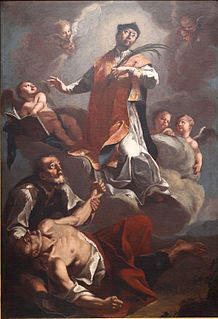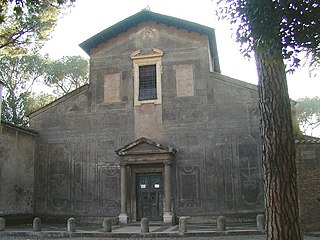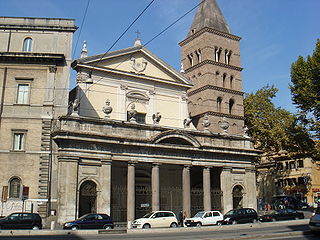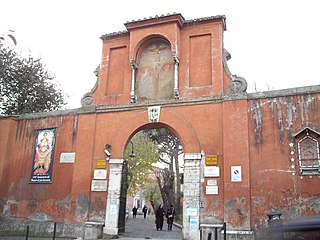History
Italian archaeologist Antonio Bosio was the first to enter the catacomb, into the upper level (no longer visible today). The first archaeologist to excavate the remains of the catacomb was Orazio Marucchi (1852–1931): in 1878, while searching for the cemetery, he casually entered a cellar, at the foot of the Parioli hills, and he realized that it actually was a grave covered with pictures, though very ruined because of its change into a room for agricultural use. Marucchi himself also discovered the remains of the outer basilica, dedicated to Saint Valentine. New archaeological investigations were carried out in 1949 by Bruno Maria Apollonj Ghetti.
These excavations permitted to ascertain that the martyr Valentine was not buried into the catacomb, but directly into a pit outside it; on this subdial grave, Pope Julius I (336–352) built a former basilical structure, which was modified and enlarged by popes Honorius I (625–638) and Theodore I (642–649) and further restored in the following centuries until the last works carried out by Pope Nicholas II in the mid-11th century. To this century dates back the testimony of a cloister close to the basilica. The basilica was still existing in the 13th century and some remains were visible in the time of Bosio (1594).
It has also been ascertained that, during the 6th century, between the basilica and the catacomb an open-air necropolis rose, with mausoleums, tombs and sarcophaguses.
Nowadays hardly anything remains of the catacomb, especially due to the flood and the landslip that involved the area in 1986 and that made most of the galleries inaccessible. The only significant artifacts are the outer basilica and the ambulatory discovered by Marucchi in 1878 and placed at the entrance of the catacomb.
Description
The former basilica of Saint Valentine has three naves. Two apses, pertaining to different phases of the building, have been brought to light. There are also remains of an underlying crypt - probably due to the works carried out by Pope Leo III (8th–9th century) - covered in marbles, some fragments of which are still in loco.
The only significant room of the catacomb, and also the only that can be visited today, is the ambulatory discovered by Marucchi in the 19th century and converted into a cellar. This room was visited by Antonio Bosio and at that time it was still intact: therefore, thanks to the drawings that he commissioned, it is possible to decipher the remains of the frescoes still surviving. According to their make and kind, they can be dated between the 7th century and the beginning of the 8th century. Especially notable is a series of frescoes about episodes of the life of Mary , taken from the New Testament apocrypha, and the fresco of a Crucifix, a very uncommon example into a catacomb.

The Catacombs of Rome are ancient catacombs, underground burial places in and around Rome, of which there are at least forty, some rediscovered only in recent decades. Though most famous for Christian burials, either in separate catacombs or mixed together, Jews and also adherents of a variety of pagan Roman religions were buried in catacombs, beginning in the 2nd century AD, occasioned by the ancient Roman ban on burials within a city, and also as a response to overcrowding and shortage of land. The most extensive and perhaps the best known is the Christian Catacomb of Callixtus located near the Park of the Caffarella, but there are other sites, both Christian and not, scattered around the city, some of which is now engulfed in the modern urban sprawl.

Saint Valentine was a 3rd-century Roman saint, commemorated in Western Christianity on February 14 and in Eastern Orthodoxy on July 6. From the High Middle Ages his Saints' Day has been associated with a tradition of courtly love. He is also a patron saint of Terni, epilepsy and beekeepers.

The Basilica Papale di San Lorenzo fuori le mura is a Roman Catholic papal minor basilica and parish church, located in Rome, Italy. The Basilica is one of the Seven Pilgrim Churches of Rome and one of the five former "patriarchal basilicas", each of which was assigned to the care of a Latin Church patriarchate. The Basilica was assigned to the Patriarchate of Jerusalem. The Basilica is the shrine of the tomb of its namesake, Saint Lawrence, one of the first seven deacons of Rome who was martyred in 258. Many other saints and Bl. Pope Pius IX are also buried at the Basilica, which is the centre of a large and ancient burial complex.

The Basilica of Saint Praxedes, commonly known in Italian as Santa Prassede, is an early medieval titular church and minor basilica located near the papal basilica of Saint Mary Major, on Via di Santa Prassede, 9/a in rione Monti of Rome, Italy. The current Cardinal Priest of Titulus Sancta Praxedis is Paul Poupard.

San Sebastiano fuori le mura, or San Sebastiano ad Catacumbas, is a basilica in Rome, central Italy. Up to the Great Jubilee of 2000, San Sebastiano was one of the Seven Pilgrim Churches of Rome, and many pilgrims still favor the traditional list.

Santi Quattro Coronati is an ancient basilica in Rome, Italy. The church dates back to the 4th century, and is devoted to four anonymous saints and martyrs. The complex of the basilica with its two courtyards, the fortified Cardinal Palace with the Saint Silvester Chapel, and the monastery with its cosmatesque cloister is built in a silent and green part of Rome, between the Colosseum and San Giovanni in Laterano, in an out-of-time setting.

San Martino ai Monti, officially known as Santi Silvestro e Martino ai Monti, is a minor basilica in Rome, Italy, in the Rione Monti neighbourhood. It is located near the edge of the Parco del Colle Oppio, near the corner of Via Equizia and Viale del Monte Oppio, about five to six blocks south of Santa Maria Maggiore.

Santi Nereo ed Achilleo is a fourth-century basilica church in Rome, Italy, located in via delle Terme di Caracalla in the rione Celio facing the main entrance to the Baths of Caracalla. It has been the titular church of Cardinal Celestino Aós Braco since 28 November 2020.
Antonio Bosio was a Maltese scholar, the first systematic explorer of subterranean Rome, author of Roma Sotterranea and first urban spelunker.

Saints Nereus and Achilleus are two Roman martyr saints. In the present General Roman Calendar, revised in 1969, Saints Nereus and Achilleus (together) are celebrated on the 12th of May.

San Crisogono is a church in Rome dedicated to the martyr Saint Chrysogonus. It was one of the tituli, the first parish churches of Rome, and was probably built in the 4th century under Pope Sylvester I (314–335), rebuilt in the 12th century by John of Crema, and again by Giovanni Battista Soria, funded by Scipione Borghese, in the early 17th century.

The Catacomb of Priscilla is an archaeological site on the Via Salaria in Rome, Italy, situated in what was a quarry in Roman times. This quarry was used for Christian burials from the late 2nd century through the 4th century. This catacomb, according to tradition, is named after the wife of the Consul Manius Acilius Glabrio; he is said to have become a Christian and was killed on the orders of Domitian. Some of the walls and ceilings display fine decorations illustrating Biblical scenes.

Saints Marcellinus and Peter are venerated within the Christian churches as martyrs who were beheaded. Hagiographies place them in 4th century Rome. They are generally represented as men in middle age, with tonsures and palms of martyrdom; sometimes they hold a crown each.

The Basilica of Saints John and Paul on the Caelian Hill is an ancient basilica church in Rome, located on the Caelian Hill. It was originally built in 398.

The Catacomb(s) of Pontian is one of the catacombs of Rome on the Via Portuensis, notable for containing the original tombs of Pope Anastasius I (399–401) and his son Pope Innocent I (401–417). The Catacomb was discovered by famed Italian explorer Antonio Bosio in 1618.

The Catacomb of Generosa is a catacomb of Rome (Italy), located in Via delle Catacombe di Generosa, close to a big bight of river Tiber on the right bank, in the Portuense quarter.

The Catacomb of Saint Agnes is one of the catacombs of Rome, placed at the second mile of via Nomentana, inside the monumental complex of Sant'Agnese fuori le mura, in the Quartiere Trieste.

The Catacomb of San Pancrazio is a catacomb of Rome (Italy), located in the Via Aurelia, within the modern Quartiere Gianicolense.

The Catacombs of San Sebastiano are a hypogeum cemetery in Rome (Italy), rising along Via Appia Antica, in the Ardeatino Quarter. They are one of the very few Christian burial places that have always been accessible. The first of the former four floors is now almost completely destroyed.
Barbara Mazzei is an Italian archaeologist known for the discovery of the earliest iconography of the Apostles.

















